Cortes Generales
General Courts | |
|---|---|
| 15th Cortes Generales | |
| Type | |
| Type | |
| Houses | Senate Congress of Deputies |
| Leadership | |
| Structure | |
| Seats | 615 265senators 350deputies |
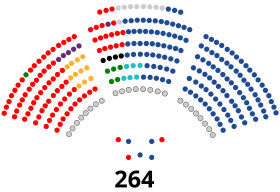 | |
Senatepolitical groups | Government(91)
Supported by (20) Opposition(153) |
 | |
Congress of Deputiespolitical groups | Government(147)
Supported by (32) Opposition(171) |
| Elections | |
FirstSenateelection | 15 June 1977 |
FirstCongress of Deputieselection | January–September 1810 |
LastSenateelection | 23 July 2023 |
LastCongress of Deputieselection | 23 July 2023 |
| Meeting place | |
 | |
| Senate Palacio del Senado Plaza de la Marina Española Centro,Madrid | |
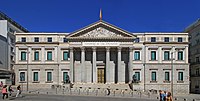 | |
| Congress of Deputies Palacio de las Cortes Carrera de San Jerónimo Centro,Madrid | |
| Website | |
| cortesgenerales | |
TheCortes Generales(Spanish pronunciation:[ˈkoɾtesxeneˈɾales];English:Spanish Parliament,lit. 'General Courts') are thebicamerallegislative chambersofSpain,consisting of theCongress of Deputies(thelower house) and theSenate(theupper house).
The Congress of Deputies meets in thePalacio de las Cortes.The Senate meets in thePalacio del Senado.Both are inMadrid.The Cortes are elected through universal, free, equal, direct and secretsuffrage,[1]with the exception of some senatorial seats, which are elected indirectly by the legislatures of theautonomous communities.TheCortes Generalesare composed of 615 members: 350 Deputies and 265 Senators.
The members of theCortes Generalesserve four-year terms, and they are representatives of the Spanish people.[2]In both chambers, the seats are divided by constituencies that correspond with thefifty provincesof Spain, plusCeutaandMelilla.However, each island or group of islands within theCanaryandBalearicarchipelagos forms a different constituency in the Senate.[3]
As aparliamentary system,the Cortes confirm and dismiss thePrime Minister of Spainand theirgovernment;specifically, the candidate for Prime Minister has to be invested by the Congress with a majority of affirmative votes. The Congress can also dismiss the Prime Minister through avote of no confidence.The Cortes also hold the power to enact a constitutional reform.
The modernCortes Generaleswere created by the 1978Constitution of Spain,but the institution has a long history.
History[edit]
This sectionneeds additional citations forverification.(December 2020) |
Visigothic Kingdom[edit]
Thetribal councilsorganized underGermanic lawin theVisigothic Kingdomhad the power of appointing and confirming kings, as well as passing laws and judgment. TheVisigothic Codecompiled underkingsChindasuinthandRecceswinthin the mid-7th century placed the kings,Visigoths,andnative Spanishunder asingle lawand formed the basis ofSpanish lawthrough the medieval period. The Visigothic councils, however, gradually came to be completely dominated bythe clergyunder the leadership of thearchbishopofToledo;with ecclesiastical prerogatives completely secure, they then tended to allow royal edicts to come into effect without further ratification.[4]
High Middle Ages (8th–12th centuries)[edit]

Theroyal councils(Latin:curia regis) of theIberian peninsula's various kingdoms came to be known ascortes(Castilian Spanish) orcorts(Valencian Spanish). They began as advisory councils made up of the most powerfulnoblesand thefeudal lordsclosest to the king. General councils were convened in 873, 1020, 1050, and 1063. The1188 CortesofLeónconvened byAlfonso IXis sometimes taken to mark the beginning ofparliamentary bodiesinWestern Europe[5][page needed]because it was the first to provide formal national representation of the free urban citizens alongside the clergy and hereditary nobility. Subsequently, larger and more inclusive Cortes occurred in thePrincipality of Cataloniain 1192, theKingdom of Portugalin 1211, theKingdom of Castilein 1250, theKingdom of Aragonin 1274, theKingdom of Valenciain 1283, andKingdom of Navarrein 1300. The Leonese and Castilian Corteses were merged in 1258, after which it provided representation to Burgos, Toledo, León, Seville, Córdoba, Murcia, Jaén, Zamora, Segovia, Ávila, Salamanca, Cuenca, Toro, Valladolid, Soria, Madrid, Guadalajara, and (after 1492) Granada.
Rise of the bourgeoisie (12th–15th centuries)[edit]
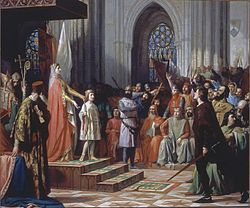
During theReconquista,the growth of trade and an urbanized middle class (Spanish:burguesía) expanded their importance at the various corteses.[citation needed]The king retained the ability to call and dismiss the Cortes but tended to exchangefueros,further grants of privileges and autonomy, to the residents of certain cities in exchange for lump sum payments to meet military and other obligations.[citation needed](ModernNavarrepreserves certain rights and privileges[which?]in its currentstatute of autonomydirectly derived from these fueros.)[citation needed]In some cases, the Cortes was able to independently select agents to act as permanent advisors to the king between its sessions.[citation needed]
Habsburg rule (16th–17th centuries)[edit]

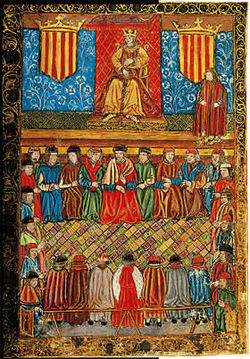
Beginning with theCatholic MonarchsIsabellaandFerdinand,monarchs' control over Spain's various kingdoms inpersonal unionallowed them to curtail the power of thegrandeesand burghers. Queen Isabella initially had difficulty in securing funding for thevoyagesofChristopher Columbusin the 1490s but her grandson theHabsburgemperorCharles V(Charles I of Spain) was able to easily provide forFerdinand Magellan's1519 expeditionand then to pointedlysell away all of Spain's rightsto theSpice Islands(nowIndonesia'sMalukus) without any consultation with the Toledo Cortes in 1529. The 1520Revolt of the Comuneroshad intended to reverse this trend and provide a stronger role for the Cortes but was crushed by theConstable's royalist forces at the 1521Battle of Villalarand then brutally suppressed.
Reorganized, the corteses retained some power over the realm's finances—particularly inAragon—but became limited to a consultative entity. By the reign ofPhilip II,the delegates of the Cortes of Castile were financially dependent on the Crown for their income.[6]The Imperial Cortes and its deputation (Spanish:Diputación General de Cortes) primarily concerned themselves with overseeing previous agreements and the collection of taxes in Castile and the larger empire; separate deputations oversaw similar work in Aragon and Navarre.[7]
The corteses were able to regain some of their previous powers and influence during the 17th century, as repeatedsovereign defaultsreduced the monarchy to financial dependency and a series of deputies including theCount-Duke of Olivaresoversaw most day-to-day government. Under the young and chronically illCharlesII,the Cortes of Castile was responsible for naming his motherMarianaregent.
Bourbon rule (18th–19th centuries)[edit]
During theWar of the Spanish Succession,theBourbonkingPhilipVsuppressed the Cortes of Aragon and Valencia in 1707 and those of Catalonia and theBalearic Islandsin 1714. Following thePeace of Utrecht,the 1716Nueva Planta Decreesfully abolished the autonomy of theCrown of Aragon.Philip also acted to repeal or curtail most of the diverse grants of autonomy and privilege (fueros) throughout his kingdom.Navarrewas finally merged during the1833 territorial division of Spain.[8]
Napoleonic Spain and the Three Liberal Years[edit]

With both the Bourbon monarchsCharles IVandFerdinand VIIhaving abdicated their throne andNapoleon Bonapartehaving appointed his brotherJosephas the new king, a "Cortes of Cádiz"was convened that claimed sovereignty over Spain and operated as agovernment-in-exile.The Cortes was the first to act as a single representative body for the entire country and empire, although substitutes had to be chosen from among the people ofCádizfor many regions occupied by the French and unable to send their own delegates. Extremely liberal, theConstitution of 1812enacted by the Cortes was immediately set aside by Ferdinand upon his restoration in 1814. His conservative policies led to a series of military coups that culminated inCol.Rafael del Riegoforcing him to accept a more liberal constitution from 1820–1823, theTrienio Liberal( "Three Liberal Years" ). Ferdinand vetoed nearly every law passed during the period and repeatedly asked other nations to invade and restore him to his previous authority. Finally,a French invasioncrushed the National Militia and restored absolutist rule in Spain. During the subsequent reaction, many liberals were forced into exile, many—ironically—ending up in France, but generally Ferdinand VII was less strident in his policies through the remainder of his reign.
First Spanish Republic (1873–1874)[edit]
When the monarchy was overthrown in 1873, the king was forced into exile. TheSenatewas abolished because of its royally appointed nature. A republic was proclaimed and theCongress of Deputiesmembers started writing a Constitution, supposedly that of afederal republic,with the power of Parliament being nearly supreme (seeparliamentary supremacy,although Spain did not use theWestminster system). However, due to numerous issues, Spain was not ready to become a republic; after several crises the government collapsed, and the monarchy was restored in 1874.
Restoration (1874–1930)[edit]
The regime just after the First Republic is called theBourbon Restoration.It was formally aconstitutional monarchy,with the monarch as arubberstampto the Cortes' acts but with some reserve powers, such as appointing and dismissing the Prime Minister and appointing senators for the newSenate,remade as an elected House. In practice there was an artificial two-party system calledEl Turno Pacífico(peaceful rotation) in which elections were informally fixed so the Conservatives and Liberals would have alternating periods as the majority in the Cortes, with other parties restricted to a smaller number of seats.
Soon after theSoviet revolution(1917), the Spanish political parties started polarizing, and the left-wingCommunist Party(PCE) andSpanish Socialist Workers' Party(PSOE) blamed the Government for supposed election fraud in small towns (caciquismo), which was incorrectly supposed to have been wiped out in the 1900s by the failedregenerationistmovement. In the meantime, spiralling violence started with the murders of many leaders by both sides. Deprived of those leaders, the regime entered a general crisis, with extreme police measures which led to a dictatorship (1921–1930) during which the Senate was again abolished.
Second Spanish Republic (1931–1939)[edit]
The dictatorship, now ruled by AdmiralAznar-Cabañas,called for local elections. The results were overwhelmingly favorable to the monarchist cause nationally, but most provincial capitals and other sizable cities sided heavily with the republicans. This was interpreted as a victory, as the rural results were under the always-present suspicion ofcaciquismoand other irregularities while the urban results were harder to influence. The King left Spain, and a Republic was declared on 14 April 1931.
The Second Spanish Republic was established as apresidential republic,with aunicameralParliament and a President of the Republic as theHead of State.Among his powers were the appointment and dismissal of thePrime Minister,either on the advice of Parliament or just having consulted it before, and a limited power to dissolve the Parliament and call for new elections.
The first term was the constituent term charged with creating the newConstitution,with the ex-monarchist leaderNiceto Alcalá Zamoraas President of the Republic and the left-wing leaderManuel Azañaas Prime Minister. Theelectiongave a majority in theCortesand thus, the Government, to a coalition between Azaña'spartyand the PSOE. A remarkable deed isuniversal suffrage,allowing women to vote, a provision highly criticized by Socialist leaderIndalecio Prieto,who said the Republic had been backstabbed. Also, for the second time in Spanish history, some regions were granted autonomous governments within the unitary state. Many on the extreme right rose up with GeneralJosé Sanjurjoin 1932 against the Government's social policies, but the coup was quickly defeated.
The elections for the second termwere held in 1933and won by the coalition between the Radical Party (center) and theConfederación Española de Derechas Autónomas(CEDA) (right). Initially, only the Radical Party entered the Government, with the parliamentary support of the CEDA. However, in the middle of the term, several corruption scandals (among them theStraperloand theNombelaaffairs) sank the Radical Party and the CEDA entered the Government in 1934. This led to uprisings by some leftist parties that were quickly suffocated. In one of them, the left wing government of Catalonia, which had been granted home rule, formally rebelled against the central government, denying its power. This provoked the dissolution of theGeneralitat de Catalunyaand the imprisonment of their leaders. The leftist minority in the Cortes then pressed Alcalá Zamora for a dissolution, arguing that the uprising were the consequence of social rejection of the right-wing government. The President, a former monarchist Minister wary of the authoritarianism of the right, dissolved Parliament.
Thenext electionwas held in 1936. It was hotly contested, with all parties converging into three coalitions: the leftistPopular Front,the right-wingedNational Frontand a Centre coalition. In the end, the Popular Front won with a small edge in votes over the runner-up National Front, but achieved a solid majority due to the new electoral system introduced by the CEDA government hoping thattheywould get the edge in votes. The new Parliament then dismissed Alcalá-Zamora and installedManuel Azañain his place. During the third term, the extreme polarisation of the Spanish society was more evident than ever in Parliament, with confrontation reaching the level of death threats. The already bad political and social climate created by the long-term left-right confrontation worsened, and many right-wing rebellions were started. Then, in 1936, the Army's failed coup degenerated into theSpanish Civil War,putting an end to the Second Republic.
From November 1936 to October 1937, the Cortes were held atValencia City Hall,which was still being used for its local purposes at the same time. The building was a target for theItalian Air Forcein service of theNationalist faction,resulting in a bombing in May 1937.[9]
Francoist Spain (1943–1977)[edit]
Francisco Francodid not prioritize the creation of a consultative or legislative type of assemblyduring his rule.[10]In 1942, following the first symptoms of change in the international panorama in favour of theAllied Powers,a law established the Cortes Españolas (Spanish Cortes), a non-democratic chamber made up of more than 400procuradores(singularprocurador). Both the Cortes' founding law and the subsequent regulations were based on the principles of rejection of parliamentarism and political pluralism.[11]Members of the Cortes were not elected and exercised only symbolic power. It had no power over government spending, and the cabinet, appointed and dismissed by Franco alone, retained real legislative authority. In 1967, with the enaction of theOrganic Law of the State,the accommodation of "two family representatives per province, elected by those on the electoral roll offamily headsand married women "(the so-calledtercio familiar) ensued, opening a fraction of the Cortes' composition to some mechanisms of individual participation.[12]
Cortes Generales under the Constitution of 1978[edit]


The Cortes are a bicameral parliament composed of a lower house (Congreso de los Diputados,congress of deputies) and an upper house (Senado,senate). Although they share legislative power, the Congress holds the power to ultimately override any decision of the Senate by a sufficient majority (usually anabsolute majorityorthree-fifths majority).
The Congress is composed of 350 deputies (but that figure may change in the future as the constitution establishes a maximum of 400 and a minimum of 300) directly elected by universal suffrage approximately every four years.
The Senate is partly directly elected in that four senators per province are elected as a general rule and partly appointed by the legislative assemblies of theautonomous communities,one for each community and another one for every million inhabitants in their territory. Although the Senate was conceived as a territorial upper house, it has been argued by nationalist parties and theSpanish Socialist Workers' Partythat it does not accomplish such a task because 208 out of 265 members of the Senate are elected by popular vote in each province, and only 58 are representatives appointed by the regional legislatures of autonomous communities. Proposals to reform the Senate have been discussed for at least ten years as of November 2007. One of the main themes of reform is to move towards a higher level offederalizationand make the Senate a thorough representation of autonomous communities instead of the current system, which tries to incorporate the interests of province and autonomous communities at the same time.
Joint Committees[edit]
This section'sfactual accuracymay be compromised due to out-of-date information.The reason given is: The shown data is that from the XIV Legislatura (2019-2023).(May 2024) |
| Committee | Office | Chair(s) | Term | Refs |
|---|---|---|---|---|
| Relations with theCourt of Auditors | deputy | Santos Cerdán León (PSOE) | 2020–present | [13] |
| European Union | deputy | Susana Sumelzo Jordán(PSOE) | 2020–present | [14] |
| Relations with theOmbudsman | deputy | Vicente Tirado Ochoa(PP) | 2020–present | [15] |
| Parliamentary Control ofRTVE's Board and its Partnerships | senator | Antonio José Cosculluela Bergua(PSOE) | 2020–present | [16] |
| National Security | deputy | Carlos Aragonés Mendiguchía(PP) | 2020–present | [17] |
| Study of Addictions' Issues | deputy | Francesc Xavier Eritja Ciuró(ERC) | 2020–present | [18] |
| Coordination and Monitoring of the Spanish Strategy to accomplish the Sustainable Development Goals (SDGs) | deputy | Joan Mena Arca(ECP) | 2020 | [19] |
| deputy | Aina Vidal Sáez(ECP) | 2020–present |
See also[edit]
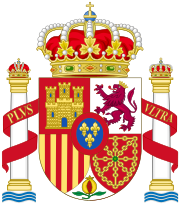 |
|---|
- List of presidents of the Congress of Deputies of Spain
- Solemn Opening of the Parliament of Spain
- Bureaus of the Cortes Generales
- Spanish Parliamentarism
Notes[edit]
References[edit]
- ^Article 68.1 and 69.1 of theConstitution of Spain(1978)
- ^Article 66 of theConstitution of Spain(1978)
- ^Article 69.3 of theConstitution of Spain(1978)
- ^Scott, Samuel Parsons, ed. (1910),The Visigothic Code (Forum Judicum),Boston, MA: Boston Book Co., pp.ix–xxi
- ^Keane, John (2009),The Life and Death of Democracy,London: Simon & Schuster.
- ^Haliczer, Stephen(1981),The Comuneros of Castile: The Forging of a Revolution, 1475–1521,Madison, Wisconsin: University of Wisconsin Press, p. 227,ISBN0-299-08500-7
- ^García de Cortázar, J.A. (1978),Historia de España(in Spanish), Alfaguara, p. 306,ISBN8420620408.
- ^García de Cortázar y Ruiz de Aguirre, José Angel (1976).La época medieval(3 ed.). Madrid: Alfaguara. p. 250.ISBN84-206-2040-8.OCLC3315063.
- ^"Cuando el Ayuntamiento de Valencia fue bombardeado"[When Valencia City Hall was bombed].El País(in Spanish). 30 May 2017.Retrieved12 October2022.
- ^Giménez Martínez 2015,pp. 71–72.
- ^Giménez Martínez, Miguel Ángel (2015)."Las Cortes de Franco o el Parlamento imposible"(PDF).Trocadero: Revista de historia moderna y contemporánea(27): 73.ISSN0214-4212.
- ^Giménez Martínez 2015,p. 75.
- ^"Current membership of Comisión Mixta para las Relaciones con el Tribunal de Cuentas".Congreso de los Diputados.Archivedfrom the original on 11 September 2021.Retrieved11 September2021.
- ^"Current membership of Comisión Mixta para la Unión Europea".Congreso de los Diputados.Archivedfrom the original on 11 September 2021.Retrieved11 September2019.
- ^"Current membership of Comisión Mixta de Relaciones con el Defensor del Pueblo".Congreso de los Diputados.Archivedfrom the original on 11 September 2021.Retrieved11 September2021.
- ^"Current membership of Comisión Mixta de Control Parlamentario de la Corporación RTVE y sus Sociedades".Congreso de los Diputados.Archivedfrom the original on 11 September 2021.Retrieved11 September2021.
- ^"Current membership of Comisión Mixta de Seguridad Nacional".Congreso de los Diputados.Archivedfrom the original on 11 September 2021.Retrieved11 September2021.
- ^"Current membership of Comisión Mixta para el Estudio de los Problemas de las Adicciones".Congreso de los Diputados.Archivedfrom the original on 11 September 2021.Retrieved11 September2021.
- ^"Current membership of Comisión Mixta para la Coordinación y Seguimiento de la Estrategia Española para alcanzar los Objetivos de Desarrollo Sostenible (ODS)".Congreso de los Diputados.Archivedfrom the original on 11 September 2021.Retrieved11 September2021.
Further reading[edit]
- O’Callaghan, Joseph F.The Cortes of Castile-León, 1188–1350,1989.
- Constitución Española, Título III,De las Cortes Generales,1978

